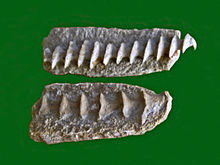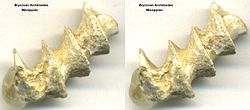Archimedes (bryozoan)
 From Wikipedia the free encyclopedia
From Wikipedia the free encyclopedia
| Archimedes Temporal range: | |
|---|---|
 | |
| Fossil stalks of Archimedes from Illinois, on display at Galerie de paléontologie et d'anatomie comparée in Paris | |
| Scientific classification | |
| Domain: | Eukaryota |
| Kingdom: | Animalia |
| Phylum: | Bryozoa |
| Class: | Stenolaemata |
| Order: | †Fenestrida |
| Family: | †Fenestellidae |
| Genus: | †Archimedes Owen, 1838 |
| species | |
| Synonyms | |
| Archimedipora d'Orbigny, 1849 | |
Archimedes is a genus of bryozoans belonging to the family Fenestellidae.[1] The first use of the term "Archimedes" in relation to this genus was in 1838.[2]
Etymology[edit]
This genus of bryozoans is named Archimedes because of its corkscrew shape, in analogy to the Archimedes' screw, a type of water pump which inspired modern ship propellers in turn named after the ancient greek polymath. These forms are common as fossils but they have been extinct since the Permian.
Species[edit]
- Archimedes orientalis Schulga-Nesterenko 1936
- Archimedes regina Crockford 1947
- Archimedes stuckenbergi Nikiforova 1938
Fossil range[edit]
These bryozoans lived from the Carboniferous period (Tournaisian age) to the Permian period (Leonard age) (345.3 to 268.0 Ma), when this genus became extinct.[3][4]
Description[edit]
| Stereo image | |||
|---|---|---|---|
| |||
| |||
| |||
| |||
| Fossilized skeleton of Archimedes Bryozoan. | |||
Archimedes is a genus of fenestrate bryozoans with a calcified skeleton of a delicate spiral-shaped mesh that was thickened near the axis into a massive corkscrew-shaped central structure. The most common remains are fragments of the mesh that are detached from the central structure, and these may not be identified other than by association with the "corkscrews", that are fairly common. Specimens in which the mesh remains attached to the central structure are rare.[5] Like other bryozoans, Archimedes forms colonies, and like other fenestrates, the individuals (or zooids) lived on one side of the mesh, and can be recognized for the two rows of equally distanced rimmed pores. Inside the branches, neighbouring individuals were in contact through small canals. Bryozoans are stationary epifaunal suspension feeders.[3]
Distribution[edit]
The majority of fossils of this genus are distribute throughout Europe and North America, but they have also been found in sediments of Afghanistan, Canada, Russia, and Australia.[3]
References[edit]
- ^ Col, Jeananda, 'Archimedes', Dinosaur and Paleontology Dictionary, 1996, accessed March 8, 2011
- ^ Duncan, Helen M. and W.H. Easton. "Archimedes and its Genotype." Journal of Paleontology. SEPM Society for Sedimentary Geology. Vol. 27, No. 5 (Sep., 1953), pp. 737–741.
- ^ a b c d The Paleobiology Database
- ^ Sepkoski, Jack Sepkoski's Online Genus Database - Bryozoa
- ^ Mckinney, Frank, K.; Burrdick, Dennis W. (2001). "A rare, larval-founded colony of the bryozoan Archimedes from the Carboniferous of Alabama". Palaeontology. 44 (5): 855–859. doi:10.1111/1475-4983.00204. S2CID 129819584.
{{cite journal}}: CS1 maint: multiple names: authors list (link)
